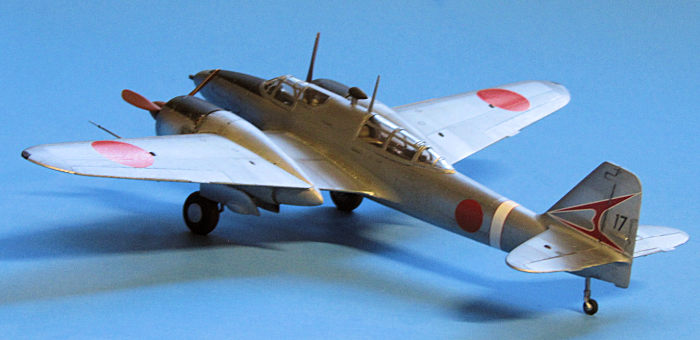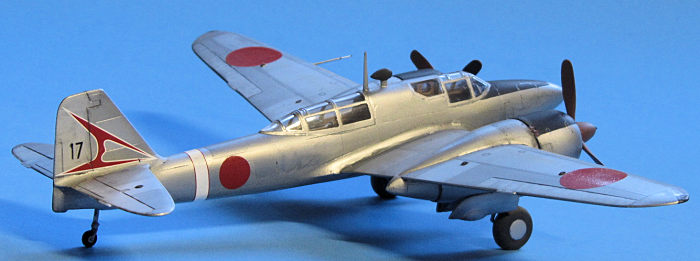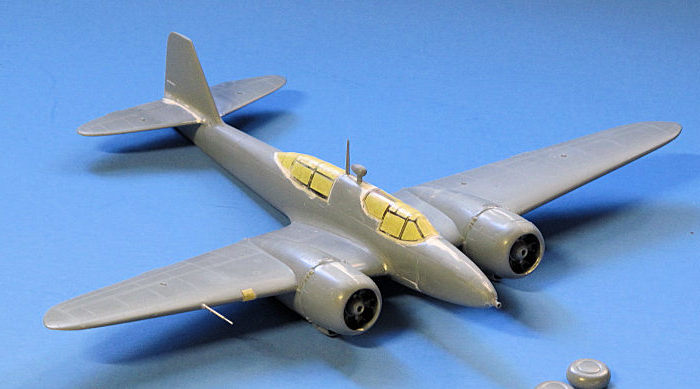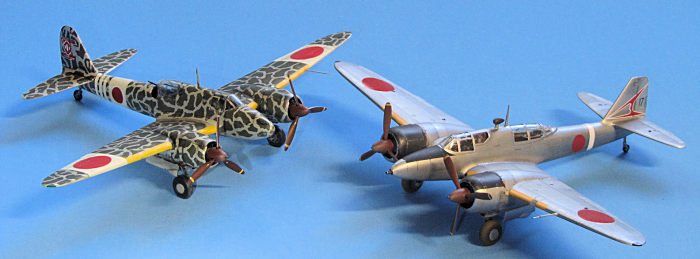
| KIT #: | 72102 |
| PRICE: | $28.00 SRP |
| DECALS: | Three options |
| REVIEWER: | Ryan Grosswiler |
| NOTES: | Short run kit |

| HISTORY |
(Since this is such a poorly-documented aircraft in
Western sources I'll write a bit more than usual)
If ever there was an airplane whose history summarizes the chaos throughout the Japanese military's high command in the last years of World War II, it is this one.
 ng. These appeared as a
slightly larger Toryu with a square tail, the offensive armament deficiency
corrected with a package of two 20mm cannons and a third of no less than
57mm in bore (firing a 3-pound shell) fed by a 16-round magazine. A set of
bomb racks could be fitted under the fuselage about level with the wing
leading edge, and a 12.7mm machine gun operated by the aft crewmember
covered the rear quarter.
ng. These appeared as a
slightly larger Toryu with a square tail, the offensive armament deficiency
corrected with a package of two 20mm cannons and a third of no less than
57mm in bore (firing a 3-pound shell) fed by a 16-round magazine. A set of
bomb racks could be fitted under the fuselage about level with the wing
leading edge, and a 12.7mm machine gun operated by the aft crewmember
covered the rear quarter. Parallel to
this, Kawasaki's drafting and prototyping shops had responded to all the
Army's convulsions quite deftly, and by now had become so accustomed to the
IJAAF's vacillating that they proactively planned three separate versions of
the new Ki-102 in anticipation of the service's needs, the -Ko supercharged
high-altitude day interceptor; the prototyped -Otsu for
ground attack; and -Hei night
fighter, the first major design change. Soon, at the Army's urging, a pressurized high-altitude
day interceptor, the Ki-108, was added to this development schedule, along
with a smaller, stripped down and unnamed/undesignated day fighter which
sacrificed everything for speed. In short, even as
the base Ki-102b/Otsu began trickling into production in December 1944, its
parent company's efforts were being dissipated into developing the aircraft
into no less than FIVE versions, three of them substantially different.
The design flew really well right off the drawing board, the only problems being marked yaw instability on takeoff/landing and the ferocious recoil of that 57mm blunderbuss. The former was temporarily remedied by fitting a long tail wheel leg to reduce the ground angle: a 1-meter fuselage stretch was supposed to be the permanent solution but the pressing need for aircraft prevented this from being implemented on the assembly line. The latter was presumably solved by telling pilots to man up and deal with it.
By now,
however, a new enemy--literally, and to the production effort--had appeared:
the B-29. USAAF bombing led to production being relocated no less than three
times. Nonetheless, this football of an aircraft managed to enter mass
series, with over 200 of the -Otsu being built and 20 or 30 of the high
altitude -Ko (modified from Otsu airframes). Two prototypes of the -Hei
night fighter were almost finished when damaged beyond repair by--you
guessed it--yet another B-29 raid. Through the chaos, the Randy managed to
actually enter frontline service in substantial numbers, with several
tactical-fighter units reequipping on the typ e before war's end.
e before war's end.
For decades, all that was known in the West about this "action" were spare, cryptic remarks by aviation titan-historians Rene Francillon and Bill Gunston in their works amounting to "the Ki-102 was mostly held in reserve in Japan in anticipation for the home islands invasion, but a few saw limited action over Okinawa where the type became known as 'Randy' to the Allies". No evidence or substantiation is provided for this, nor do either quote their sources. Francillon does includes images of a Ki-102 photographed in 1945 among several other captured Japanese Army aircraft allegedly at Clark Field in the Philippines (Francillon, pages 219 & 234). The vegetation and structures visible do strongly suggest a setting outside the Home Islands. Still, it's obscured, with the tell-tale vertical tail invisible in the brush: it may simply be an all-green Ki-45.
Recorded more specifically is the Ki-102's service over the Home Islands, drawn primarily from an article in the incomparable French periodical Avions (Issue #140, Nov. 2004) which itself drew from Japanese sources. Because I don't speak/read a syllable of French, I resorted to Google Translate (and my own knowledge of the way human languages work) to get the gist of the text. I used this material along with some corroboration from other references in English for the following:
The 3rd and 75th Sentais were the first recipients of the Ki-102. Both were Ki-48 Lily units which had been decimated in the Philippines in the fall of 1944, their remnants ordered back to Japan immediately afterward to reequip on the new fighter. These two groups were stationed on Noshiro and Hachinohe, respectively, to await the anticipated Allied invasion of Japan. A Ki-45 Sentai, the 45th, was also recalled from the Philippines for similar duty but was still in training on their new airplane at Hokota when the war ended. A fourth group (the 28th) equipped with the Ki-46 III-Kai was given a few of the Ki-102 Ko and Otsu for operational evaluation. The squadron flew several interceptions against B-29s with unconfirmed results during April 1945.
A fifth
"unit", actually the IJAAF test center at Fusa (near Tokyo), had also
received a mixed bag of Ki-102 -Ko and -Otsu for operational evaluation,
with two of its pilots gaining concrete results. Given a supercharged -Ko,
Nomonohan-veteran 51-kill ace Maj. Yasuhiko Kuroe flew
several missions against B-29s between December 1944 and March of 1945. The
first were flown without incident, but in March he finally made contact with
a Superfortress formation at 34,000' over Tanashi and made several passes,
trading shots with the American gunners until finally his right engine was
damaged and he was forced to return to base. Later that month, Kuroe finally
scored hits on a B-29, which began to burn and descend before he was again
forced to break the fight. He was later formally credited with the shootdown.
Some sources credit Kuroe with two kills (Sakaida,
P.33) on these missions.
contact with
a Superfortress formation at 34,000' over Tanashi and made several passes,
trading shots with the American gunners until finally his right engine was
damaged and he was forced to return to base. Later that month, Kuroe finally
scored hits on a B-29, which began to burn and descend before he was again
forced to break the fight. He was later formally credited with the shootdown.
Some sources credit Kuroe with two kills (Sakaida,
P.33) on these missions.
In
June, Lt. Miyoshi Shimamura departed
Fusa in an -Otsu, holding in hand a test card for airborne evaluation of the
57mm gun. By accident, he ran across another B-29 formation at 26,000'.
Lining up on one unfortunate member of it, a single burst from all three
guns sent the mighty bomber into a spin in which it disintegrated.
So--two or three kills and several probables for all that effort. Without a doubt, the Randy would have been a major presence over the invasion beaches had the Allies stormed Kyushu in November 1945 as planned, but history obviously went elsewhere. No example of the Ki-102 survives today, even though one each of the -Ko and -Otsu versions were brought back to the United States for evaluation following the war. There is still the Smithsonian's Ki-45, whose fuselage sits on a cart in the Udvar-Hazy center at this writing, looking like a frozen brook trout, while aviation geeks puzzle online whether or not the museum has the rest of the aircraft squirreled away somewhere like it did with the B-26Flak Bait.
| THE KIT |
The Ki-102 in 1/72: despite the fact that this is a
genuine WWII operational type and one with quite a bit of visual appeal, it
has been mostly ignored by kit manufacturers. For decades there was only the
KPL kit from the '70s: this was one of the first vac-forms I attempted. I
didn't finish it but gained some new skills, namely identifying when a
subject is under-scale and methods to correct that. A Czechmaster special
order resin kit next came out in 1995 through Aviation Usk, but I never laid
eyes on it owing to its $38 price tag being too rich for my bohemian blood
at the time. Pavla came out with the best-known kit a year later, an early
short-run inje cted w/photoetched parts which even included a complete 57mm
cannon, but the finished model sported a nose too pointy, cockpit too
narrow, engine nacelles and cowls way too large, and all parts having that
blah too-rounded look so characteristic of short-run kits from that period.
cted w/photoetched parts which even included a complete 57mm
cannon, but the finished model sported a nose too pointy, cockpit too
narrow, engine nacelles and cowls way too large, and all parts having that
blah too-rounded look so characteristic of short-run kits from that period.
| CONSTRUCTION |
I began with my usual short-run parts prep: first testing the canopies' fit against the fuselage. They are a little too large, but the cure is simply a 1/32" shim in the spine between the front and rear cockpits and same in front of the pilot's windshield to fix it. There is a vacuform canopy for this kit from "AP Modely" which probably resolves the issue as well. I also cut out the section specified in the instructions where the rear canopy segment revolved to expose the rear gun. A test assembly of the main parts then followed to reveal an otherwise generally good fit. Just a little had to be taken off the horizontal joint where the forward fuselage meets the lower wing part, and the locating tabs (doing more harm than good) were cut off the stabilizers and their roots filed flat. All mating surfaces were given a light sanding and I took about ten minutes with a Permagrit sander to grind down the wing trailing edges to better thinness, a problem on all short-run kits.
Major
cockpit components could then fitted. I made some changes here: 1) cut away
the 'dashboard' under the windshield and detailed the back of the
now-exposed instrument panel to match the one known cockpit photo, 2) sanded
the pilot's armor and seat to more realistic thinness, 3) added distinctive
bracing structure under the rear canopy section (like the Ki-61's), since
phot os seem to indicate this change was made sometime after the first few
prototypes, 4) cut off the top of the solid bulkhead forward of the rear
cockpit and fitted fuselage fuel tank detail, as I considered this a more
likely configuration, and 5) sprinkled in some finer components such as
seatbelts, levers, and other little do-dads following interior photos of the
better-documented Ki-45. The interior was painted khaki, weathered, and the
canopies glued on.
os seem to indicate this change was made sometime after the first few
prototypes, 4) cut off the top of the solid bulkhead forward of the rear
cockpit and fitted fuselage fuel tank detail, as I considered this a more
likely configuration, and 5) sprinkled in some finer components such as
seatbelts, levers, and other little do-dads following interior photos of the
better-documented Ki-45. The interior was painted khaki, weathered, and the
canopies glued on.
General
construction as laid out by Sword is logical enough and goes really quickly,
my only major deviation being to attach the landing gear parts 8 & 9 to the
well roof parts 51 & 46, attaching these assemblies with the forward well
walls 57 & 40 to the wing lower half. This kept the remaining landing gear
parts off and out of the way until main assembly was complete. Though not
signaled as such, parts 8 & 9 are in fact 'handed', with teeny mounting lugs
that should point inward. Doing so will strengthen the finished assembly a
little.
The main wing part was glued on, followed by the top halves. A little bit of filling was required on the lower fuselage, and after sanding this and restoring the panel lines those shallow 20mm cannon troughs were drilled out. Horizontal stabilizers were attached.
Assembling the engine cowls required tedious removal of the raised ejector towers inside the cowling halves. Propellers are designed to simply be glued on, so I spent some time on the drill press to get the props mounted on steel shafts which were then inserted into a hole drilled into the engines. The fit of the finished engine cowl assemblies on to the wing is a little imprecise; check alignment in all three axes before setting it up to cure. Lack of care here will result in engines canted upward.
Small parts
were finally attached. I replaced the pitot tube with telescoped brass for
better thinness and strength. Also, though it's a small part, knowing that
it would be a focal point on the finished model I took the time to give the
cannon's muzzle brake a bit of extra attention (and yes, that's muzzle
B-R-A-K-E. A
 "muzzle break" is damage that puts the weapon out of
action). The bore was drilled out on a carefully-centered pilot hole,
and four more smaller holes were drilled around the circumference for the
brake venting.
"muzzle break" is damage that puts the weapon out of
action). The bore was drilled out on a carefully-centered pilot hole,
and four more smaller holes were drilled around the circumference for the
brake venting.
The result looked really neat, and feeling pleased with myself, I failed to notice that I'd inadvertently created a weakened and teeny structure on the nose of the model. This was predictably smashed when I brushed an arm past it during painting prep. Quality time was then spent shaping a replacement from aluminum tube chucked into my Dremel.
The two small intakes prominent at the leading edges of the wing root aren't depicted. I caught this omission at the last moment and drilled them in through the primer coat.
| COLORS & MARKINGS |
 h this hypothesis, I was off to the paint shop, eager to try out my
newly-acquired Alclad II products.
h this hypothesis, I was off to the paint shop, eager to try out my
newly-acquired Alclad II products.| CONCLUSIONS |
| REFERENCES |
19 October 2017
Copyright ModelingMadness.com
If you would like your product reviewed fairly and fairly quickly, please contact the editor or see other details in the Note to Contributors.
Back to the Main Page Back to the Review Index Page Back to the Previews Index Page